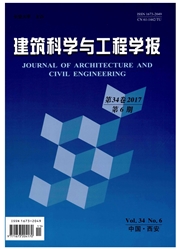

 中文摘要:
中文摘要:
为简化延性耗能节点有限元数值计算,给大型延性耗能节点钢框架结构简化计算提供基础研究,对梁翼缘局部热处理型节点、盖板加强型节点和翼缘过渡板加强型节点3种构造形式的延性耗能节点简化理论模型进行了理论和数值研究。在节点试验研究基础上引入弹簧单元设计节点简化理论模型,根据弹簧单元广义力和广义位移关系设定弹簧本构关系,充分反映节点域和节点连接组件变形。采用ANSYS有限元软件对节点简化理论模型进行数值计算,提取节点弯矩-转角滞回曲线,将其与试验结果进行对比。结果表明:滞回曲线和试验结果吻合较好,简化理论模型能够体现延性耗能节点的实际力学性能和塑性区发展过程;所得结论可为延性耗能节点钢框架结构数值分析提供新方法。
 英文摘要:
英文摘要:
In order to simplify finite element numerical calculation of ductile and energy-dissipated connections and afford basic research for simplified calculation of ductile and energy-dissipated connections in steel frame structures,according to heat-treated beam section connection,coverplate reinforced connection and flange-plate reinforced connection,theoretical and numerical studies on three kinds of simplified theory models of ductile and energy-dissipated connections were conducted.On basis of test study of connections,simplified theory models were designed by introducing spring element,and constitutive relations of the springs were defined according to generalized force and generalized displacement relationship of spring elements,which fully reflected deformation of the panel zone and connection components.Numerical calculation of connection simplified theory models was carried out by using ANSYS software,moment-rotation hysteresis curves were obtained and compared to test results.The results show that hysteresis curves are consistent with test results,and simplified theory model can reflect real mechanical property of ductile and energy-dissipated connection and development of plastic zone.The resultswill provide new method for numerical analysis of steel frame structure with ductile and energydissipated connections.
 同期刊论文项目
同期刊论文项目
 同项目期刊论文
同项目期刊论文
 期刊信息
期刊信息
